Prom 13 review: Rana, BBCSO, Davis – Malcolm Sargent tribute lacks punch
Historical recreation of 500th Prom short of sparkle until Britten finale
Ten days ago I reviewed the First Night of the 2017 Proms. Last night I was back at the Royal Albert Hall to hear the First Night of the 1966 Proms. This time-capsule experience was courtesy of a re-enactment of Sir Malcolm Sargent’s 500th Prom, in what turned out to be his final season. It gave an idea of Sargent’s musical tastes – middle-of-the-road classics and English music – and, in places, of his famously audience-pleasing conducting style.
Prom 3: Faust, COE, Haitink - Europeans tread air under 88-year-old master
Sheer perfection and personality in Mozart and Schumann
The message must be getting through. On the First Night of the Proms, Igor Levit played as encore Liszt's transcription of the great Beethoven melody appropriated as the European Anthem; in Prom 2, Daniel Barenboim unleashed his Staatskapelle Berlin on Elgar's Pomp and Circumstance following an inspirational speech about European culture, education and humanism. Yesterday afternoon's manifesto was a given, showcasing the finest of all European bands under a Dutch citizen of the world who resided for many years in London. Bernard Haitink is also the world's greatest living Mozart conductor now that Mackerras is no longer with us - and at 88, his baton technique and his nuancing are more focused than ever in the love and passion they inspire.
You might argue that the Chamber Orchestra of Europe could play the programme in question without a conductor. But Haitink (pictured below) fine-tuned the dynamics in Mozart's "Prague" Symphony, No. 38, adding many more than are in the score, with a notably magical dimuendo back into the first-movement recap, and added his own subtle sense of space throughout, starting with the end of the slow introduction.
All repeats cried out to be heard with playing as hyper-alert and well sprung as this - and especially in Mozart's Andante, which Haitink now, surely, conducts more swiftly than he used to, making it a deeply expressive kind of minuet in a three-movement symphony where that ritual is officially missing.The woodwind playing was predictably both cultured and vivid, from Kai Frömbgen's very personal oboe solos to Clara Andrada's flute loudly protesting against the sudden ensemble rudeness at the heart of the finale.
Mozart's ubiquitous Third Violin Concerto might have seemed one-dimensional after that, a nice little exercise in 18th century gallantry, but not with another peerless artist, Isabelle Faust (pictured below), who as one-time COE member had to join her fellow violinists in the opening tutti. If from a distance in the Albert Hall you had to lean in to catch the nuances, that's no bad thing; and Faust's vibrato-light line in the Adagio was a delight. So was her choice of startling cadenzas by her frequent duo partner, pianist Andreas Staier, the last introducing a repeated pizzicato in homage to Mozart's use of it in a belated rondo-theme and carrying it over into the final fun and games.
No doubts, either, about any aspect of Schumann's Second Symphony – not an obvious second-half work – could possibly remain in an air-treading performance like this. The much-derided orchestration seemed perfect, with low horn notes cutting as much as the rest of the orchestra through the Albert Hall vasts. Haitink convinced us that this is one of the most miraculous scherzos ever written, so deft and sleight-of-hand in its transitions that you really wanted to applaud it and even call for an encore, as they did of old mid-symphony. The actual bonus, then, was apt, perfection again: the most gossamer-light dance through the Scherzo from Mendelssohn's incidental music to A Midsummer Night's Dream, proving that Haitink at 88 is still an ageless Puck at heart.
- Listen to this Prom on the BBC iPlayer for the next month
- Read more classical music reviews on theartsdesk
Next page: watch Daniel Barenboim's inspiring pro-European speech in Prom 2
theartsdesk Q&A: Horn-player Alec Frank-Gemmill
Four horns, four pianos, one CD; an original among musicians tells us why, and more
Traditional musical formats rarely suit the individual talent, but the highly-motivated player always finds a way. I first got to talk to Alec Frank-Gemmill in the very sociable surroundings of the Pärnu Festival in Estonia, a gathering most musicians describe as the highlight of their year, with the phenomenal Estonian Festival Orchestra brought together by Paavo Järvi as its core. Frank-Gemmill's secure base is the Scottish Chamber Orchestra, another army of unusual generals. His solo engagements take him to extraordinary places, and thanks to the long-term support of the Borletti-Buitoni Trust, an organisation whose roster of young musicians reads like a musical who's who, he's just been able to record a horn and piano recital with a difference.
The subtitle of the disc, reviewed today on theartsdesk by fellow horn-player Graham Rickson, tells of its idiosyncrasy: "Music for horns and pianos of the 19th century". In other words two natural, two valve horns, and pianos by Lagrassa, Streicher, Blüthner and Bechstein. It's a captivating CD, unusually amenable for a recital to listening through at a single sitting; I've already played it four times. And it justifies the unique possibilities of the recorded format. Frank-Gemmill has also made individual commentaries on each of the pieces, which punctuate the interview. He told me about the motivation, and the larger question of orchestral versus solo work, on his lunch break from work as a professor at the Guildhall School of Music and Drama.
DAVID NICE A normal horn and piano disc could be monotonous, but your idea of varying the horns and varying the pianos too – that must have taken a lot of thought and work.
ALEC FRANK-GEMMILL Well, there's so many CDs out there. I could see the point – I'm interested in hearing other horn players and their interpretations, but there aren't that many differences between players of any instrument these days, and if you aim to do something different for the sake of it, that could be quite cheap. But to do this is actually providing some historical context, and was just a means for me to do something new. So it is hopefully in some way original and worth doing.
 I think actually – well, not in the case of all the pieces, not the later ones like [Glazunov's] Rêverie – with the other ones you could find on the internet each individual track [done authentically] and shove them together, however you wouldn't get the same person playing, so you wouldn't really be able to compare the sounds. Also my interpretations were based in part on what the horn wanted to do. That was part of the inspiration – I'm trying to make a distinction, not to do something definitive or claim it's the right way, but just for me to present it, so if this horn wants to play the piece like that and it's a horn I know the composer would have recognised, then that immediately inspires me to do something in a particular way, rather than – say, if I'd been born 30 years earlier, I might fall into the trap of saying, this is how it went then. And these 19th century horns are so different to each other – even a horn made in Paris in 1820 to the same design as one made in Berlin, that could change the sound utterly, so it's sort of a nod to authentic ideas. I'm not suggesting that this is the definitive recording, but I'm suggesting that it is something which could maybe enlighten us about how it might have sounded, so to that degree it is historical.
I think actually – well, not in the case of all the pieces, not the later ones like [Glazunov's] Rêverie – with the other ones you could find on the internet each individual track [done authentically] and shove them together, however you wouldn't get the same person playing, so you wouldn't really be able to compare the sounds. Also my interpretations were based in part on what the horn wanted to do. That was part of the inspiration – I'm trying to make a distinction, not to do something definitive or claim it's the right way, but just for me to present it, so if this horn wants to play the piece like that and it's a horn I know the composer would have recognised, then that immediately inspires me to do something in a particular way, rather than – say, if I'd been born 30 years earlier, I might fall into the trap of saying, this is how it went then. And these 19th century horns are so different to each other – even a horn made in Paris in 1820 to the same design as one made in Berlin, that could change the sound utterly, so it's sort of a nod to authentic ideas. I'm not suggesting that this is the definitive recording, but I'm suggesting that it is something which could maybe enlighten us about how it might have sounded, so to that degree it is historical.
...And how you can actually physically play, because if you've got weak and strong notes on the natural horn, it dictates the tempo...
Absolutely. For me, that was a joy. But I'm sure if I'd come to the disc as a different sort of player who already likes his particular tempos, it would have felt like a hindrance. So for me it was lovely, it gave the pieces some new reasons to be done. Especially on disc, because then you can sit down from beginning to end and hear the different sounds.
And it makes a fine programme, too.
Yes, it was nice because I could choose all the best pieces from the 19th century, rather than just thinking, oh, this has been done a million times. [Schumann's] Adagio and Allegro, someone has played it on a modern Vienna horn, and I think there's a recording somewhere on an old Vienna horn. They are very similar instruments, but rather like horns made now instead of in 1905, they are bigger and more orchestral and fatter and less intimate. That Beethoven Horn Sonata, quite a few people have recorded that now on natural horn.
Do they get the flourishes as well as you do at the end of the first movement, those fantastic arpeggios?
Well you know, that bit on natural horn just works – I didn't have to practice. That's lovely because it doesn't just feel like an easy piece with a couple of hard bars, it feels like a nice piece and you're just working on how to phrase it. [Below: the first of four films in which Frank-Gemmill introduces the different 19th century horns on the disc]
Do you have a particular favourite sound amongst all those?
I think it's totally subjective – it's clouded by what I found a struggle and what came easily. Probably my favourite thing is the Rossini [Prelude, Theme and Variations], because I never liked the piece before this disc, and I find it really attractive now played on the natural horn. But maybe with a bit more distance, the Rêverie sounds so right on that horn with an old fashioned, almost proto-Hollywoodesque sort of warmth but also a bit of clunkiness – ahh, it was so nice to play that piece like that!
The essence of the horn to me is the warm, rounded Brahms sound – how do you feel about that now?
I touch very briefly on that in the notes [in the CD booklet, excellent] when I talk about Franz Strauss, because we now have the view of what the horn is, and these pieces might give a slightly different perspective; but I agree, that's why we all took up the horn, and I think that's the universally appealing, romantic, deep sound, and Brahms understood that immediately. But what's interesting about Brahms is that he often preferred the natural horn because it got closer to that, and probably in the 19th century – I've only just thought of this since you said that – maybe the whole development was about finding the esence of what the horn is in the romantic era. And now you can buy horns that are much harder to miss notes on. I think I could play on those because I've got my own job and I could just decide what technology I wanted, but I wouldn't let any of my students play them. Because it's not what the horn is – some of the beauty of it is to do with the struggle. The natural horn is of course much harder than the modern horn, but then when you do manage, it's that much more beautiful as well. Actually, that's bad advice, better not think that [big laugh].
When you were studying, was there a particular sound you were aiming for, or you were told to aim for by your teacher?
I could be swayed a bit more easily at the time. And like a lot of people I took up the horn because of Dennis Brain, and that sound – you couldn't really be employed making the kind of sound he made. Well, you could as a soloist, I suppose, but you would be out on the lunatic fringe. Which might be quite nice. Then my problem, or my luck, is that I feel inspired by different orchestras and different players in different repertoire, so I don't have any idol for every single piece, and maybe half my problem but half my success has been searching to the n-th degree for a particular way of playing a particular composer with a particular sound.
But that's the ideal, isn't it, it's about the music and not about the player...
Exactly. But some of my teachers were astonishing. Anyway, I love listening to the Vienna Phil playing Mahler, I love listening to the LSO playing Mahler, then probably hearing the Scottish Chamber Orchestra in a Mozart symphony
There are lots of orchestras doing brilliant things all the time but I have my particular tastes. It's funny because sometimes orchestras ring you up and offer you work, or even offer you a concerto, and they don't say we'd like this concerto, or this patch of work is this composer, and you think, I don't know if I want to do this, because what if it's my least favourite Shostakovich symphony with nothing to do in it, or what if it's Mahler Nine, that seems crazy to me. At some point you've got to earn money, but I'd quite like to earn money and pick and choose my favourite music.
Next page: on future options, the music not the player, and more on the choices of horns and pianos
Jonathan Biss, Milton Court
Intellectual rigour guides a range of last thoughts, but the hall is forbidding
"Late Style", the theme and title of pianist Jonathan Biss's three-concert miniseries, need not be synonymous with terminal thoughts of death. This recital ranged from introspection (Brahms), radiant simplicity (Schumann) and aphoristic minimalism (Kurtág) to robust self-assertion (the end of Chopin's Polonaise-Fantaisie, Brahms again), all of it guided by strength of intellect.
Mitsuko Uchida, Royal Festival Hall
Compelling accounts of Schumann and Mozart offer darkness and light
Mitsuko Uchida specialises in elegant, if uncontroversial, interpretations of core Austro-German repertoire, yet she’s never predictable, and every performance is full of unexpected insights and welcome surprises.
The Schumann Project, Oxford Lieder Festival
Late songs, requiems and ensembles find serenity in times of trouble
It felt oddly disrespectful showing up in time for Schumann's wake on the fifteenth and final day of this year's Oxford Lieder Festival. Having started with the early piano music and many of the chamber works before moving on to Schumann's annus mirabilis of song, 1840, with frequent leaps backwards to influences and forwards to the influenced, pianist Sholto Kynoch’s labour of love reached the troubled final years dogged by whatever that insanity for which Schumann was institutionalised might have been – bipolarity, syphilis, poisoning for the mercury used in its treatment.
Isserlis, Mustonen, Wigmore Hall
Ineffable programming of Schumann and Prokofiev from a spellbinding duo
For a BBC Radio 3 lunchtime's hour of music, cellist Steven Isserlis's latest collaboration with that most individual of pianists Olli Mustonen went astonishingly deep. The surprises were equal in its two halves - the first a through-conceived programme of shortish late Schumann pieces plus a Schumann homage composed by Mustonen the composer for Isserlis and poetically embedded in the sequence; the second an interpretation of Prokofiev's late Sonata for Cello and Piano which scotched with high, focused drama the usual claims that this is a light and simple work.
First Person: Steven Isserlis on Schumann's advice to the young
The cellist and writer on a new book annotating a great composer's wisdom
All musicians have particular musical passions, composers, styles or genres to which they are irresistibly drawn. I have many – almost too many at times; but among the most enduring is my love for the music, writing and personality of Robert Schumann. Another important aspect of my musical life – another passion, in fact - is the work I get to do with young musicians.
Jeremy Denk, Wigmore Hall
Panorama of musical history reveals surprising connections
Medieval to Modern – Jeremy Denk’s Wigmore Hall recital took us on a whistle-stop tour of Western music, beginning with Machaut in the mid-14th century and ending with Ligeti at the end of the 20th. The programme was made up of 25 short works, each by a different composer and arranged in broadly chronological order, resulting in a series of startling contrasts, but punctuated with equally surprising, and often very revealing, continuities.


